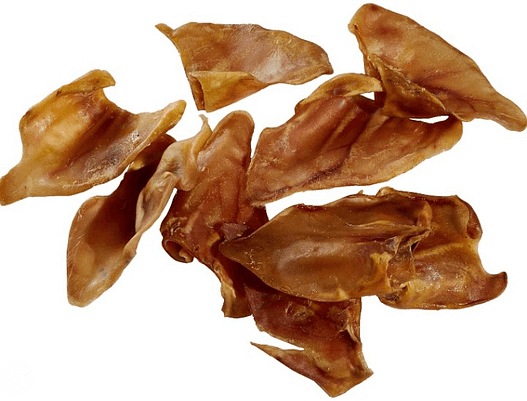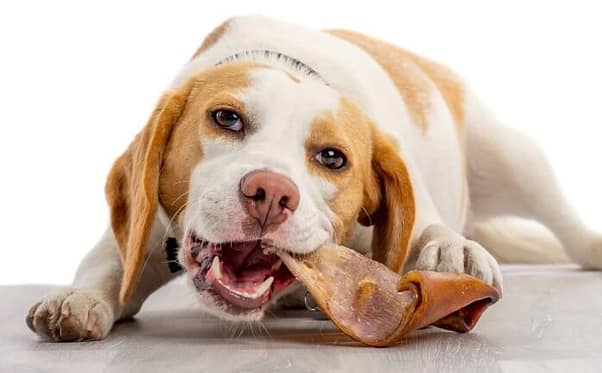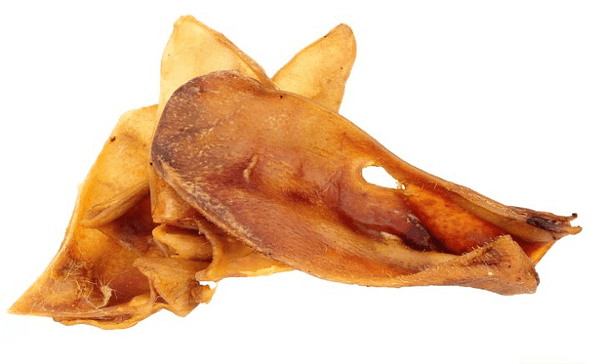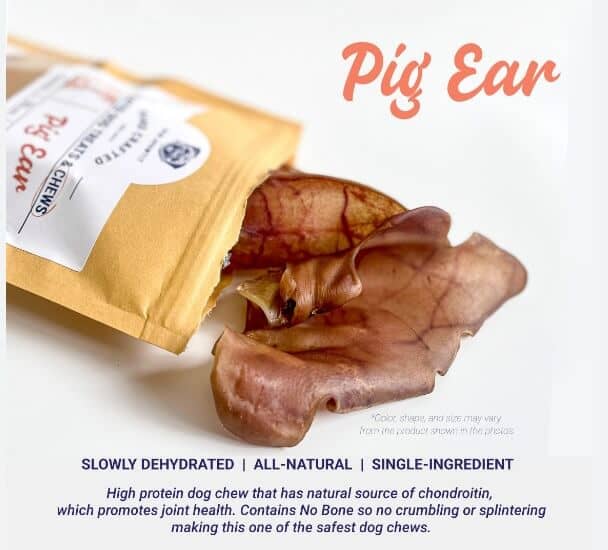Pig ears for dogs have gained significant popularity in recent years, with many pet owners considering them as a treat or supplement to their canine companion’s diet. These chewy snacks are often praised for their palatability and entertainment value, making them an appealing choice for both dogs and their owners.
However, it is crucial to approach this topic with caution, as there are potential risks associated with feeding pig ears to dogs. This article aims to provide an objective analysis of pig ears as a dietary option for canines, focusing on the benefits they offer while also addressing the necessary precautions that should be taken into consideration.
By examining the nutritional composition, potential hazards, and appropriate selection of pig ears for dog consumption, pet owners will be equipped with the knowledge needed to make informed decisions about incorporating these treats into their furry friend’s diet.
Key Takeaways
- Pig ears are nutrient-rich and flavorful, providing essential vitamins, minerals, and protein.
- Chewing pig ears can promote dental health by reducing tartar buildup and strengthening jaw muscles.
- It is important to consult with a veterinarian before introducing pig ears into a dog’s diet.
- There are alternative chew options like rawhide and dental chews that offer similar benefits and cater to different preferences.
What are Pig Ears?
Pig ears are a popular dog treat made from the cartilage of pig’s ears, providing dogs with a tasty and satisfying chewing experience. However, it is important to consider the nutritional value of pig ears when serving them to dogs.

Pig ears are high in fat content and can lead to weight gain or digestive issues if consumed excessively. Therefore, moderation is key when offering pig ears as a treat. It is also essential to be aware of any potential allergies or sensitivities that your dog may have towards pork products.
For those looking for alternatives to pig ears, there are several options available. Bully sticks, deer antlers, and dental chews are all excellent choices that provide similar benefits for dogs without the high-fat content of pig ears. These alternatives offer a long-lasting chew while promoting dental health and preventing boredom.
In conclusion, while pig ears can be enjoyed as an occasional treat for dogs, it is crucial to consider their nutritional value and potential alternatives to ensure the overall well-being of our beloved pets.
Why Dogs Love Pig Ears
Canine companions are instinctively drawn to the rich aroma and irresistible flavor of this beloved treat. Pig ears provide a satisfying chewing experience for dogs, which is one of the primary reasons why they love them.
Chewing is a natural behavior for dogs that helps keep their teeth clean and strong. The act of chewing on pig ears promotes healthy gums and can help prevent dental issues such as plaque buildup and gum disease.

Moreover, pig ears offer several benefits beyond dental health. They serve as a distraction for dogs, helping to alleviate boredom and reduce anxiety or destructive behaviors. Additionally, pig ears are a natural source of protein and essential nutrients, contributing to a well-balanced diet.
While some dogs may have sensitivities or allergies to certain ingredients in pig ears, there are alternative options available such as rawhide chews or synthetic bones. It’s important for dog owners to consider their pet’s individual needs when choosing treats and consult with a veterinarian if necessary.
Pig Ears for Dogs Potential Risks and Precautions
This discussion will focus on potential risks and precautions related to dogs consuming pig ears.

One key concern is the choking hazard these treats pose, especially for smaller breeds or dogs who tend to gulp their food. It is crucial for pet owners to supervise their dogs while they are enjoying pig ears to prevent any accidents or choking incidents.
Additionally, allergies and sensitivities in dogs should be taken into consideration, as some canines may have adverse reactions to certain ingredients found in pig ears.
Choking hazards and supervision.
Choking hazards associated with the consumption of pig ears by dogs are significant enough to warrant constant supervision. To ensure choking prevention and proper supervision, dog owners should be aware of the potential risks and take necessary precautions. Dogs may chew on pig ears vigorously, leading to small pieces breaking off and posing a choking hazard. Owners must carefully monitor their dogs while they are consuming pig ears and intervene if any signs of distress or difficulty breathing arise. Implementing strict supervision protocols can help prevent choking incidents and ensure the safety of our furry companions.
To emphasize the importance of constant supervision, a table can be used:
| Choking Hazards | Prevention Measures | Supervision Tips |
|---|---|---|
| Small pieces breaking off | Choose appropriate-sized pig ears for your dog’s breed and size | Observe your dog closely during consumption |
| Difficulty breathing | Remove any small or broken pieces from your dog’s reach | Stay near your dog while they chew on pig ears |
| Distress or discomfort | Provide alternatives such as dental chews or toys | Learn canine CPR techniques in case of emergencies |
By following these guidelines, we can prioritize our pet’s safety and well-being when offering them pig ears as a treat option.
Allergies and sensitivities in dogs.
Allergies and sensitivities in dogs can significantly impact their overall health and well-being, highlighting the importance of understanding and managing these conditions.
Many dogs suffer from allergies to certain elements present in their diet, such as specific ingredients found in dog food. These allergies can manifest as skin conditions, causing itchiness, redness, and discomfort for the affected animal.
Identifying and eliminating potential allergens from a dog’s diet is crucial in alleviating these symptoms and improving their quality of life. In some cases, a specialized hypoallergenic diet may be recommended by veterinarians to help manage these allergies.
Regular monitoring of a dog’s skin condition is essential to promptly identify any flare-ups or reactions to certain foods so that appropriate measures can be taken to minimize discomfort and promote optimal health for our furry companions.
Choosing the Right Pig Ears for Your Dog

When choosing pig ears for your dog, it is important to consider the quality and sourcing of the product. Opting for high-quality pig ears that are sourced from reputable suppliers can help ensure that they are free from harmful additives or contaminants.
Additionally, considering the size and thickness options available is important as it allows you to choose a pig ear that is appropriate for your dog’s breed and size, reducing the risk of choking or other potential hazards.
Quality and sourcing considerations.
Quality and sourcing considerations play a crucial role in the selection of pig ears for dogs, ensuring their safety and overall satisfaction. When choosing pig ears for our furry companions, it is important to prioritize sustainable farming practices and ethical sourcing. To serve our audience that desires serving others, here are three key points to consider:
- Sustainable farming: Look for pig ears sourced from farms that follow environmentally friendly practices. These may include organic farming methods, minimal use of pesticides or chemicals, and responsible waste management.
- Ethical sourcing: Opt for pig ears from suppliers who prioritize animal welfare standards. This ensures that the pigs are raised in humane conditions and are not subjected to unnecessary suffering or cruelty.
- Transparency in sourcing: Choose brands that provide information about their sourcing practices, including the origin of the pig ears and any certifications they hold. This transparency helps ensure accountability and allows consumers to make informed decisions based on their values.
By considering these quality and sourcing factors when selecting pig ears for dogs, we can support sustainable farming practices while promoting the well-being of animals involved in the process.
Size and thickness options.
When it comes to choosing pig ears for dogs, quality and sourcing considerations are important. However, another crucial factor to consider is the size and thickness options available.

Different dogs have varying preferences when it comes to the size and thickness of pig ears. Some dogs may prefer smaller and thinner pig ears, while others may enjoy larger and thicker ones. It is essential to take into account your dog’s chewing style and jaw strength when selecting the appropriate size and thickness.
Additionally, the size and thickness of pig ears can also impact their health benefits for dogs. Thicker pig ears may provide more durability for aggressive chewers, while thinner ones may be suitable for smaller breeds or dogs with dental issues.
Ultimately, understanding your dog’s preferences and considering their individual needs will help you choose the right size and thickness of pig ears for them.
Incorporating Pig Ears into Your Dog’s Diet
Incorporating pig ears into your dog’s diet provides a nutrient-rich nutrisource dog food and flavorful addition that can enhance their overall well-being and satisfaction. Pig ears offer several benefits for dogs, including being a natural source of protein and essential nutrients like vitamins and minerals. Additionally, they serve as an alternative chew option to promote dental health by reducing tartar buildup and strengthening jaw muscles.

When considering incorporating pig ears into your dog’s diet, it is important to keep in mind the size and thickness of the ear to ensure they are suitable for your dog’s breed and chewing capabilities. It is recommended to consult with a veterinarian before introducing pig ears or any new food item into your dog’s diet.
Furthermore, it is advisable to consider other alternative chew options such as rawhide or dental chews that can provide similar benefits while catering to different preferences or dietary restrictions. By offering a variety of chew options, you can cater to your dog’s individual needs and preferences while ensuring their overall well-being.
See Also:
- Airdale Terrier: Remarkable Power and Endless Positivity
- How To Become A Dog Groomer
- Russian Bear Dog
- Empower Positive Behavior with the Best Dog Training Collar
- Experience the Magic of Affenpinschers: Find Your Perfect Companion at Bone Voyage Dog Rescue
Conclusion
In conclusion, pigs ears can be a popular and enjoyable treat for dogs, offering a satisfying chewing experience. These natural treats are often rich in flavor and texture, which can keep dogs entertained and occupied. However, it’s essential to provide pigs ears in moderation and under supervision, as they are high in fat and calories. As with any treat, it’s crucial to consider your dog’s dietary needs and potential allergies.
If introduced responsibly, pigs ears can be a delightful occasional reward for your canine companion. Always consult with your veterinarian to ensure that pigs ears are a suitable addition to your dog’s diet and to maintain their overall health and well-being.
“If you can’t find the right dog for you to adopt locally, please consider adopting a dog from Bone Voyage Dog Rescue. We’ll fly with your dog to you.”
Frequently Asked Questions
How often should I give my dog pig ears as a treat?
Pig ears can be harmful to dogs if given too frequently. To choose the best pig ears for dogs, opt for ones that are sourced from reputable suppliers, free from additives and preservatives, and properly dried or cooked to ensure safety.
Are there any specific breeds of dogs that should not have pig ears?
Breeds to avoid feeding pig ears to include those prone to gastrointestinal issues, such as Bulldogs and Pugs, as well as dogs with food allergies. Health risks associated with pig ears may include bacterial contamination, choking hazards, and potential intestinal blockages.
Can pig ears cause any dental issues in dogs?
Pig ears can potentially cause dental issues in dogs due to their chewy texture and high fat content. To minimize these problems, pig ears should be prepared by slow-cooking or dehydrating them to reduce the risk of tooth damage and plaque buildup.
Are there any alternatives to pig ears that provide similar benefits for dogs?
There are several alternatives to pig ears that provide similar benefits for dogs. Some options include beef or chicken jerky, dental chews, and natural bones. These alternatives can help promote dental health and provide dogs with a satisfying chewing experience.
How can I properly store pig ears to ensure they stay fresh for my dog?
Proper storage is crucial to maintain freshness of pig ears. Ensure they are stored in a cool, dry place away from direct sunlight and moisture. Consider using airtight containers or resealable bags to prolong their shelf life.
